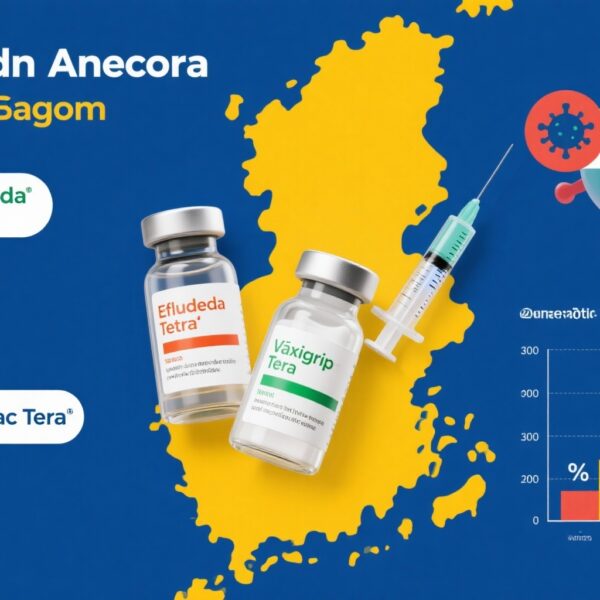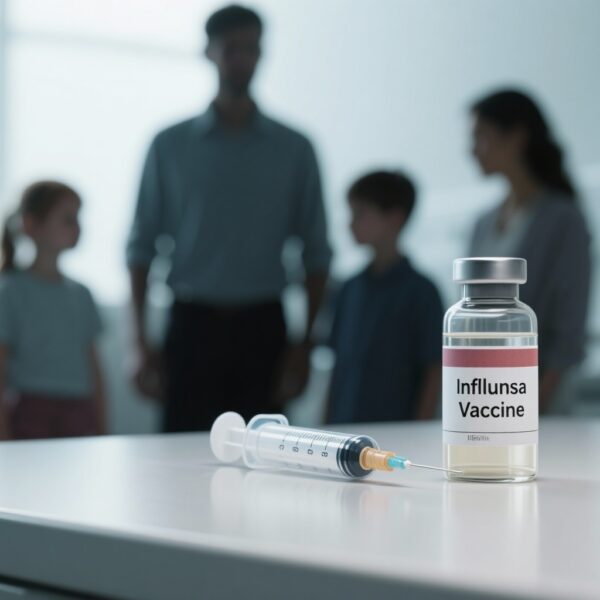Highlight
– A phase 3, non‑randomised immunobridging study (NCT05513053) compared immune responses to a single dose of recombinant quadrivalent influenza vaccine (RIV4) in 9–17‑year‑olds versus 18–49‑year‑olds during the 2022–23 northern hemisphere season.
– Haemagglutination inhibition (HAI) geometric mean titre (GMT) ratios for all four strains met the pre‑specified non‑inferiority criteria; seroconversion differences were also consistent with non‑inferiority for each strain.
– Solicited local and systemic reactions within 7 days were reported less frequently in children/adolescents than adults; no vaccine‑related serious adverse events or deaths were reported.
Background
Seasonal influenza causes substantial morbidity across age groups, and children can both suffer direct disease burden and serve as amplifiers of community transmission. Vaccination remains the cornerstone of influenza prevention. Recombinant haemagglutinin (HA) influenza vaccines are produced without egg‑based propagation, avoiding egg‑adapted changes in HA that can reduce antigenic match, particularly for A(H3N2) strains. RIV4 (recombinant quadrivalent influenza vaccine) is licensed for adults in many jurisdictions, but data supporting paediatric use have been limited.
Study design
This was a phase 3, open‑label, non‑randomised immunobridging study conducted at 36 centres across Europe and the USA during the 2022–23 northern hemisphere influenza season (ClinicalTrials.gov NCT05513053). The objective was to show that immune responses to one dose of RIV4 in participants aged 9–17 years were non‑inferior to those in adults aged 18–49 years.
Population
Healthy participants aged 9–49 years were enrolled. Key exclusion criteria included receipt of an influenza vaccine within 6 months before enrolment and receipt of other vaccines within 4 weeks before or after study vaccination (COVID‑19 vaccines were permitted if administered at least 2 weeks before or after enrolment). The study enrolled 1,308 participants; 1,299 received study vaccine (641 aged 9–17; 658 aged 18–49).
Intervention and follow‑up
All participants received a single dose of quadrivalent RIV and were followed to day 181 with visits on days 9, 29, and 181. Blood samples for immunogenicity were obtained at baseline and day 29. Safety data were collected throughout the study period, including solicited reactions within 7 days post‑vaccination.
Endpoints and statistical criteria
Primary outcomes related to immunogenicity assessed by haemagglutination inhibition (HAI) assays at day 29: (1) GMT ratios (paediatric/adult) for each of the four vaccine strains, with non‑inferiority defined as the lower bound of the two‑sided 95% CI > 0.667; and (2) differences in seroconversion rates, with non‑inferiority defined as the lower bound of the two‑sided 95% CI ≥ −10% for each strain. Safety endpoints included solicited local and systemic reactions, unsolicited adverse events, serious adverse events (SAEs), and adverse events of special interest over the follow‑up period.
Key findings
Participant characteristics
Among 1,308 enrolled participants, mean age was 13.0 years (SD 2.5) in the 9–17 group and 34.3 years (SD 9.2) in the 18–49 group. Overall, 54% were female. The cohort was predominantly White (77%), with 19% Black or African American; 11% identified as Hispanic or Latino.
Immunogenicity
In the per‑protocol analysis set, HAI GMT ratios (paediatric/adult) at day 29 were:
- A/H1N1: 2.0 (95% CI 1.7–2.3)
- A/H3N2: 3.3 (95% CI 2.8–3.9)
- B/Victoria: 1.6 (95% CI 1.4–1.8)
- B/Yamagata: 1.2 (95% CI 1.1–1.4)
All GMT ratio lower bounds substantially exceeded the non‑inferiority threshold of 0.667, indicating stronger or at least comparable humoral responses in 9–17‑year‑olds compared with adults.
Seroconversion rate differences (paediatric minus adult) at day 29 were:
- A/H1N1: 1.9% (95% CI −2.8 to 6.6)
- A/H3N2: −0.6% (95% CI −4.4 to 3.2)
- B/Victoria: 3.3% (95% CI −1.6 to 8.1)
- B/Yamagata: 14.3% (95% CI 9.2 to 19.3)
All lower bounds were ≥ −10%, satisfying the pre‑specified non‑inferiority criterion. Notably, the B/Yamagata seroconversion difference favored the paediatric group by a clinically relevant margin, suggesting higher seroconversion in adolescents.
Safety and reactogenicity
The safety profile was broadly comparable between age groups. Solicited local and systemic reactions within 7 days post‑vaccination were reported in 44% (274/618; 95% CI 40–48) of children/adolescents and 53% (336/635; 95% CI 49–57) of adults — a lower frequency in the younger cohort. No related serious adverse events, deaths, or adverse events of special interest were reported during the study.
Expert commentary and interpretation
This immunobridging study demonstrates that a single dose of RIV4 generates robust HAI responses in 9–17‑year‑olds that are non‑inferior — and in some endpoints superior — to responses in 18–49‑year‑olds. The larger GMT ratios for A(H3N2) and A(H1N1) are consistent with the high immunogenicity of HA delivered by recombinant technology, which avoids egg‑adapted antigenic changes that can blunt responses to certain strains.
Strengths
- Large, multi‑centre sample with high vaccine uptake and near‑complete follow‑up for the primary immunogenicity endpoint.
- Clear pre‑specified non‑inferiority margins and standard HAI assays performed at baseline and day 29.
- Safety monitoring to 6 months adds reassurance about medium‑term tolerability.
Limitations and considerations
- Open‑label, non‑randomised immunobridging design: while appropriate for regulatory bridging, it does not provide evidence of clinical efficacy (protection against laboratory‑confirmed influenza) in children.
- HAI titres are a surrogate of protection; their correlation with clinical effectiveness can vary by age and strain, particularly for A(H3N2).
- Study excluded younger paediatric ages (<9 years) and children who had received influenza vaccine in the prior 6 months; therefore, findings cannot be extrapolated to infants, toddlers, or vaccine‑naïve younger children who may require a two‑dose primary series.
- Demographic representation skewed toward White participants; subgroup effectiveness and safety in diverse populations merit ongoing evaluation.
- Industry funding (Sanofi) is disclosed; independent post‑licensure surveillance and real‑world effectiveness studies are important to corroborate these results.
Regulatory and clinical implications
Immunobridging is an accepted regulatory pathway to extend indications when direct efficacy trials are impractical, provided the adult reference population has established efficacy. The robust non‑inferior immunogenicity and acceptable safety profile in 9–17‑year‑olds support consideration by regulators for pediatric indication expansion of RIV4. Before routine pediatric use, agencies may request additional data addressing younger age groups, two‑dose schedules for vaccine‑naïve children, coadministration with routine pediatric vaccines, and post‑marketing effectiveness and safety surveillance.
Practical takeaways for clinicians and policymakers
– The data indicate that RIV4 elicits strong antibody responses in adolescents and older children, with fewer short‑term solicited reactions than in adults.
– Clinicians should note that immunobridging supports immunogenicity comparability but does not substitute for clinical effectiveness data; ongoing monitoring and evaluation of real‑world effectiveness will be important if pediatric use is authorized.
– Public health programs evaluating options for pediatric influenza vaccination should weigh the theoretical benefits of recombinant vaccines (no egg adaptation, potentially improved match for H3N2) against local availability, cost, and established performance of existing egg‑ or cell‑based vaccines.
Conclusion
This phase 3 immunobridging study (NCT05513053) found that one dose of recombinant quadrivalent influenza vaccine induced HAI responses in 9–17‑year‑olds that were non‑inferior to responses in 18–49‑year‑olds, with an acceptable safety profile and fewer solicited reactions in the younger cohort. These results provide a strong immunologic basis for regulatory consideration of RIV4 in adolescents and older children, while highlighting the need for additional data on younger age groups, clinical effectiveness, and real‑world safety.
Funding and clinicaltrials.gov
Funding: Sanofi.
ClinicalTrials.gov identifier: NCT05513053.
References
Folegatti PM, Pepin S, Tabar C, Fries K, Talanova O, See S, Essink B, Bertoch T, Drazan D, Natalini Martínez S, Konieczny M, Kaas‑Leach K, De Bruijn I. Comparative assessment of immunogenicity and safety of recombinant influenza vaccine in children, adolescents, and adults: results from a phase 3, immunobridging, open‑label, non‑randomised study. Lancet Infect Dis. 2025 Oct;25(10):1097‑1105. doi: 10.1016/S1473‑3099(25)00153‑7. Epub 2025 May 21. PMID: 40412421.
ClinicalTrials.gov. Study of RIV4 in Participants Aged 9 to 49 Years. NCT05513053. https://clinicaltrials.gov/ct2/show/NCT05513053



